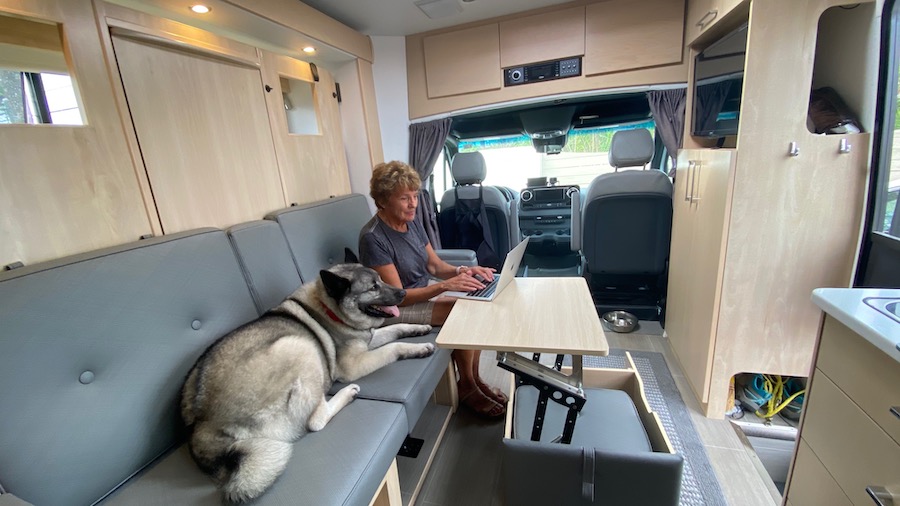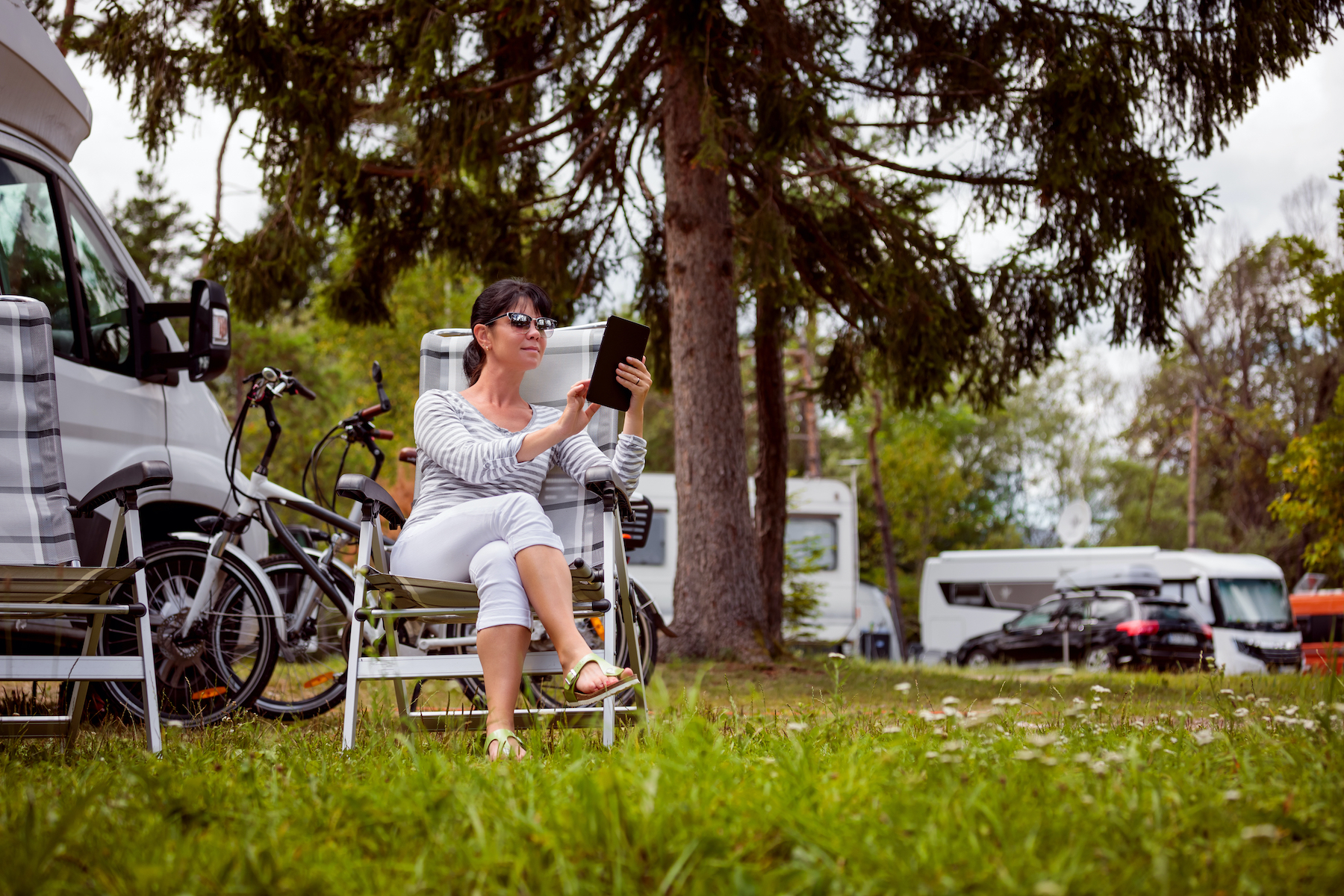2020 was known as the “Year of the RV.” One big reason for that is because 2020 was also the “Year of the Remote Worker.”
With so many working out of the office, doing their jobs virtually from the road in the RV is a much better choice than being confined to a sticks and bricks building.

But with that have come some challenges. Reliable Internet connectivity is often not available to RVers who roam far and wide from their normal home bases.
For casual travel, where the Internet is a convenience rather than a necessity, a cell phone and a public Wi-Fi connection at a campground may be all that is needed. If the signal just isn’t there in one place, no big deal. They can wait.
But for nomadic workers who must be connected to do their jobs as they travel, robust connectivity is at the top of the must-have list.
Let’s look at some common work-from-the-road connectivity issues, and how to solve them.
Public Wi-Fi Is Not Reliable
You may think that public Wi-Fi is good enough to use for work. The truth is, whether the public Wi-Fi is coming from a campground, a fast-food restaurant, or even a free hot spot connection from a municipality, it is not reliable.
Public Wi-Fi is insecure – meaning it can easily be hacked. It is also slow, with speeds capped to prevent movie downloads and streaming services. Also, it is shared, meaning the more users on at any given time, the more it is subject to crashing.

Smartphone or Tablet Data Plans Are Not Enough
Let’s talk about cellular Internet via smartphones or tablets. While a step up in terms of speed over public Wi-Fi, almost all carriers cap their cellular data usage via smartphones. That means when you reach a certain amount of data usage (typically 15 GB a month), you will either be cut off or “throttled,” meaning your Internet speeds will be dropped to barely a crawl until the next month’s usage cycle begins.
So let me put it a little more bluntly: If you are a remote worker who must have solid connectivity, you need more than a smartphone or Starbucks.
“Unlimited data,” Really Isn’t Unlimited
All of the carriers like to advertise that they have unlimited data plans. But you really have to search the fine print to see that most also have caps or limits on how much high-speed data you can use.
In other words, after you reach a limit or cap, the high speed may not be so high speed.
Technically, the carriers can get away saying unlimited because if you exceed the cap, you won’t pay overages, and you’ll still have access, but your data will slow to a crawl if you go over your limit.

Get Data Accounts With Multiple Carriers
Now let’s turn to what you should do connect to the internet and do your job.
I do almost all of my work from the road and we are on the road at least 75% of the time. Normally, I use my Verizon data connection. But sometimes, I can’t get through. That happened most recently at the very remote Flamingo Campground, located at the far end of the Everglades on Florida Bay.
It was late on a Sunday when we made the 32-mile trip down a two-lane road through the swamp to get to the campground. We were set to do our regular Sunday evening “Ask Us Anything” Livestream on our RV Lifestyle YouTube Channel. But I had no signal from Verizon. Not even a single bar.
That’s why I was glad I had redundancy with an AT&T Nighthawk data connection. It had three bars, and we were able to go on and do our show. Since then, that has happened several times. Sometimes, there was no Verizon, just AT&T. Other times, it was just the opposite.
So my advice is if you must get through and you plan to travel across the nation, get data accounts with two different carriers, be it Verizon, AT&T, Sprint, or T-Mobile.

Juggle Your Data Caps Between the Different Providers
Another reason having two different carriers is a good move for remote RV workers is because of those pesky “caps” I mentioned above. You may not use more than 15 gigs of data per month. But if you are doing a lot of Zoom calls, downloading video, streaming movies, or playing online games in your personal usage, you may regularly be crossing those limits.
With two data connections, you can typically get 30 gigs a month or more (carriers are always changing those caps). And that’s enough for all but 24×7 online gamers.
Data Connections vs. Smartphone/Tablet Connections: What’s the Difference?
I keep using the term data connections. By that, I mean a dedicated device for data, like a JetPack, a Mi-Fi, a Nighthawk, or – as we use in our RV – a Winegard ConnecT 2 rooftop Wi-Fi booster and 4G LTE hotspot.
These devices typically have a Sim card tied to a data-only account. They are typically treated separately from the data you use on your smartphone or tablet. That means the data you use on your smartphone or tablet is not eating into the plan used for your work-related data and vice versa.
Now you will need to check this out with the carriers you use. They are always changing their data caps, policies, and pricing. I am not going to suggest specific programs or promotions as they come and go with regularity.
Beware of Resellers. Deal Directly with Carriers.
Besides the carriers, you may encounter attractive sounding offers of unlimited and unthrottled Internet access from private companies known as “resellers.” A reseller cuts a deal with a cellular carrier to commit to buying massive amouts of data, which they usually get at reduced prices. In turn, they create data packages with enough markup to make a profit, which they then resell to consumers.
The problem is the carriers can change their prices pretty much whenever they want. There are many complaints about resellers changing prices or, worse yet, suddenly going out of business. It’s often a good deal when you can get it, but there’s no guarantee that the deal will last.
To avoid this inconvenience, I recommend dealing directly with the carriers. You still may have your data deal pricing and terms change but the carriers are usually a much more stable business entity than the resellers.
For Weak Signals, a Cell Phone Booster Will Help

We’ve been RVing and remotely working from our RV for nine years now. When we first started, there were many areas where we’d find ourselves with a very weak signal. That has gradually improved over the years to the point that today, I’d say we have no trouble with a connection 90% of the time.
Most of our camping is boondocking—the more remote, the better. But cellular 4G LTE coverage is not so widespread and robust that it is very rare that we cant connect.
In those cases, a cell booster can help. A cell booster does just what its name implies. It takes a weak signal and amplifies it, so your connection is solid.
If there is no signal, as we experienced in the Everglades, there is nothing to boost. But we’ve had great success with a booster in those cases where there is only one bar.
Beware of bargain boosters. A good cell booster will cost several hundred dollars and consist of an external antenna you need to mount on the roof to snag those cellular signals and an internal antenna inside the RV that rebroadcasts them to your device.
Brands we can recommend are weBoost, King, and Supertalker.
Try a Combo Wi-Fi Booster and Cellular Antenna
The solution we’ve been using in our last two RVs with great success is the Winegard Connect 2.0 Wi-Fi & 4G LTE extender. It is a round, half dome-shaped device on the roof of our RV that connects to and boosts Wi-Fi signals and has a 4G LTE antenna. It creates a connection hotspot and rebroadcasts either Wi-Fi signals or 4G LTE in and around your RV.
It is not a cell booster. But because the 4G LTE antenna it uses is mounted high up on the roof, it pulls in signals much better than you would inside the RV
Winegard ships the Connect 2.0 with its own Sim card (they act as a reseller), or you can go to your own carrier and get their Sim card. That’s what I did, putting in a Verizon SIM card.
What about 5G?
There is a lot of excitement about the next generation 5G cellular technology that is now being rolled out around the country. My newest Apple iPhone 12, for example, has 5G capabilities. But rarely do I find a 5G connection, and if I do and I am on the road, I lose it after just traveling a few miles down the road.
It is indeed super fast, as good or even faster than what you may have on your home Internet. Eventually, it will replace 4G LTE.
But there are different tiers of 5G, and right now, even though I am starting to see it show up in remote data routers, the technology is just not available widely enough that I can recommend it to RVers. Besides, it is really costly right now. The 5G Nighthawk Router that AT&T sells, for example, costs over $500.
The Real Future for Remote RV Workers = Satellite Internet
In the near future, hardcore digital nomads will use using the Starlink Satellite Service. This is what really excites me.
SpaceX, the private company working with NASA for the next moon landing and an eventual rocket launch to Mars, has put into low earth orbit what is known as a “constellation” of 480 satellites.
They are up there right now. Their sole purpose is to provide lightning-fast Internet connectivity. They need to get another few hundred up and working to provide full coverage over the continental U.S. and over 12,000 for global coverage. It takes several months once launched for the satellites to get in the exact position, and special equipment for RVs (antennas, receivers, routers) will need to be installed.
So, even though SpaceX hopes to open access up in a beta test by the end of 2020, we’re still a year away before the full constellation is operational for the continental U.S. and then the system is going to have to undergo lots of controlled testing.
Realistically, I don’t see Starlink becoming a viable reality for most RVers until 2022 or maybe even 2023. But it sure is exciting.
Bottom Line: It’s Never Been easier to be a Digital Nomad
For remote-working RVers, it’s never been easy to stay connected to the job while touring the country. And with 5G and Starlink on the horizon, it’s only going to get easier.
Happy Trails, Fellow Nomads!
Hope to see you out there….











Check out Google Fi as well.
When determining your tow vehicle you must not only consider the towing capacity, but the stopping capability. Can your vehicle stop all that weight that is pushing you?
I looked into Starlink. In the fine details and the FAQ they say it’s designed for a fixed location. Maybe someday Starlink will work for the RV crowd, but not today according to their site.